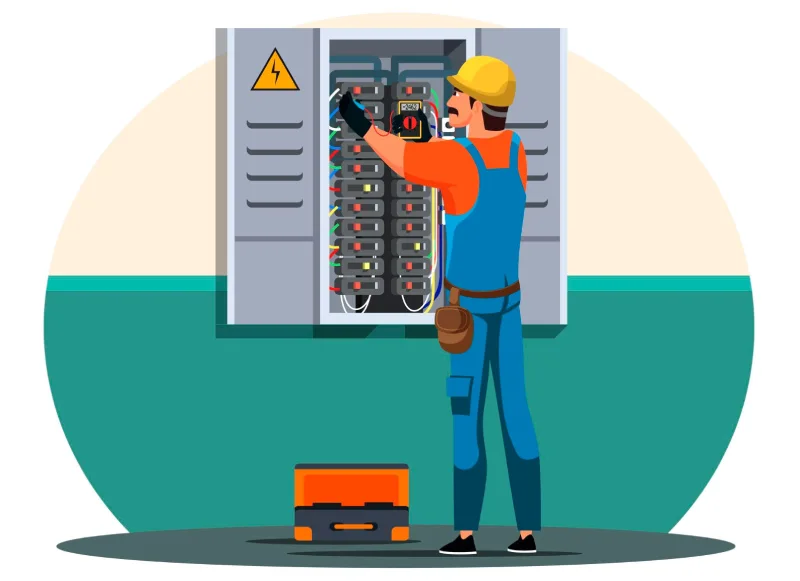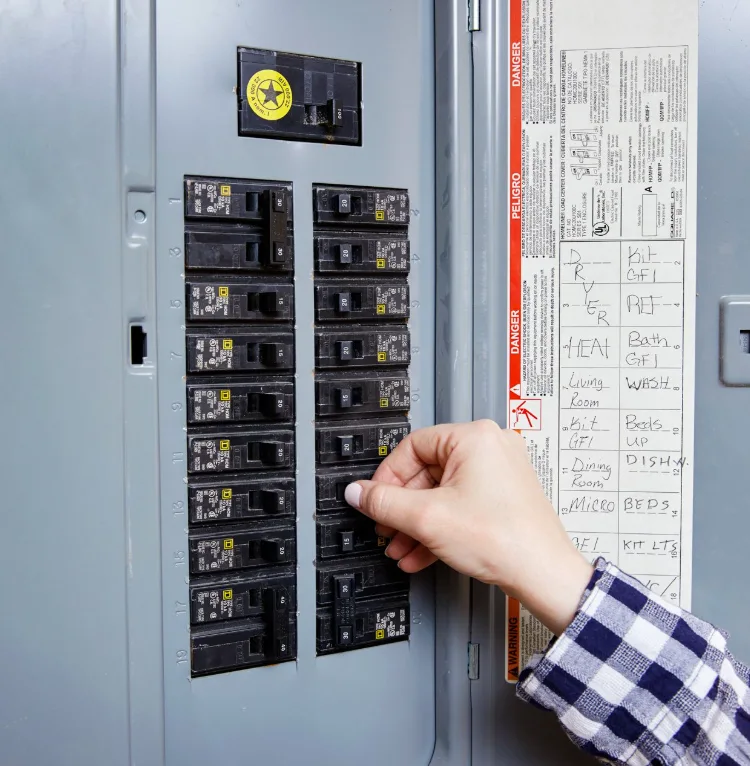The main breaker is typically located at the top of your home’s panel elektryczny (breaker box), which is most commonly found on an exterior wall, in the basement, garage, utility room, or near the electric meter. Understanding your main breaker’s location is crucial for emergency power shutoffs and electrical safety.
⚠️ OSTRZEŻENIE DOTYCZĄCE BEZPIECZEŃSTWA: Always exercise extreme caution around electrical panels. If you’re unsure about any electrical work, consult a licensed electrician immediately.
What is a Main Breaker and Why Does Location Matter?
Main Breaker Definition
A główny wyłącznik is the primary automatyczny wyłącznik that controls all electrical power entering your home from the utility company. It acts as the master shutoff switch for your entire electrical system, typically rated between 100-200 amps for residential properties.
Why Knowing the Location is Critical
- Emergency shutoffs during electrical fires or flooding
- Electrical work preparation by contractors
- Power management during storms or outages
- Zgodność z wymogami bezpieczeństwa with local electrical codes
- Home inspection requirements for real estate transactions
Main Breaker Location by Home Type: Quick Reference Table
| Home Type | Most Common Location | Secondary Locations | Access Notes |
|---|---|---|---|
| Single-Family Home | Garage or exterior wall | Basement, utility room | Usually at eye level |
| Townhouse/Condo | Interior utility closet | Garage, basement | May be shared panel |
| Apartment | Kitchen/hallway closet | Bedroom closet | Often labeled unit number |
| Mobile Home | Exterior panel near meter | Under-home utility area | Weather-protected box |
| Older Homes (Pre-1960) | Basement near meter | Fuse box instead of breakers | May need electrical upgrade |
Step-by-Step Guide to Locating Your Main Breaker
Step 1: Start with the Electric Meter
- Go outside and locate your electric meter (usually mounted on exterior wall)
- Look nearby for a gray or tan metal box (electrical panel)
- Check within 10 feet of the meter – code requires close proximity
Step 2: Check Common Interior Locations
- Basement: Near where power lines enter the home
- Garage: Along walls, typically opposite the house entrance
- Utility room: Often combined with water heater/HVAC equipment
- Kitchen area: In older homes, sometimes in kitchen closets
- Hallway closets: Especially in apartments and condos
Step 3: Identify the Main Breaker
- Otwórz pokrywę panelu (if safe to do so)
- Look for the largest breaker – usually at the top
- Check the label – should read “MAIN” or show highest amperage (100A, 150A, 200A)
- Verify it controls multiple circuits – not just one outlet or appliance
Wskazówka eksperta: The main breaker is typically twice the width of standard circuit breakers and has two switches that move together.
Main Breaker Types and Configurations
Standard Main Breaker Panel
- Lokalizacja: Top of electrical panel
- Wygląd: Double-wide breaker switch
- Funkcja: Controls all power to sub-breakers below
- Ocena: Usually matches panel capacity (100A-200A)
Main Lug Panel (No Main Breaker)
- Lokalizacja: Power controlled by exterior disconnect
- Wygląd: No main breaker in panel
- Funkcja: Direct connection from meter to panel
- Safety Note: Must locate exterior disconnect for shutoff
Split-Bus Panel (Obsolete)
- Lokalizacja: Multiple main breakers in older panels
- Wygląd: 6 or fewer large breakers at top
- Funkcja: No single main shutoff
- Recommendation: Consider electrical panel upgrade
Wymagania bezpieczeństwa i zgodność z kodeksem
Krajowy kodeks elektryczny (NEC) Wymagania
- Wysokość: Panel center between 4-6 feet from floor
- Clearance: 36 inches in front, 30 inches wide
- Dostępność: Cannot be blocked by storage or furniture
- Etykietowanie: All breakers must be clearly labeled
- Uziemienie: Proper grounding rod connection required
⚠️ Profesjonalna rekomendacja: Never remove the main panel cover unless you’re a qualified electrician. Exposed bus bars carry lethal voltage even when main breaker is off.
Emergency Shutoff Procedures
When to Use Main Breaker Shutoff
- Pożary elektryczne – Shut off immediately before calling 911
- Powódź – Turn off before water reaches electrical components
- Gas leaks – Eliminate ignition sources
- Major electrical work – Required by code for safety
- Storm preparation – Prevent power surge damage
Safe Shutoff Steps
- Ensure dry conditions – Never touch electrical panels with wet hands
- Stand to the side – Not directly in front of panel
- Use insulated tools if available
- Flip main breaker to OFF – Should click firmly into position
- Sprawdź, czy zasilanie jest wyłączone – Check lights and outlets
- Call professionals for electrical issues
Troubleshooting: What If You Can’t Find Your Main Breaker?
Common Scenarios and Solutions
Problem: No main breaker visible in panel
- Rozwiązanie: Look for exterior disconnect switch near meter
- Działanie: Check with electrician about panel upgrade needs
Problem: Multiple panels in home
- Rozwiązanie: Identify which contains the service entrance conductors
- Działanie: Main breaker is in the first panel after the meter
Problem: Apartment/condo confusion
- Rozwiązanie: Check lease documents or contact property management
- Działanie: May be located in shared electrical room
Problem: Very old home with bezpiecznik box
- Rozwiązanie: Look for main fuse or knife switch
- Działanie: Consider electrical panel modernization
Profesjonalna instalacja i konserwacja
When to Call a Licensed Electrician
- Panel upgrades from 100A to 200A service
- Main breaker replacement due to age or damage
- Code compliance issues discovered during inspection
- Flickering lights or frequent breaker trips
- Burning smells or visible damage around panel
Wymagania certyfikacyjne
- Licencjonowany elektryk required for all main breaker work
- Electrical permits needed for panel modifications
- Inspection required after major electrical changes
- Zgodność z ubezpieczeniem may require professional installation
Quick Reference Checklist for Main Breaker Location
Before You Need It
- [ ] Locate and test your main breaker function
- [ ] Ensure clear access path to electrical panel
- [ ] Label all circuit breakers clearly
- [ ] Keep flashlight near electrical panel
- [ ] Post emergency electrician contact information
Emergency Preparedness
- [ ] Know exact main breaker location
- [ ] Practice safe shutoff procedure
- [ ] Keep panel area clear of storage
- [ ] Have backup lighting available
- [ ] Know when to call professionals
Pytania i odpowiedzi
What should you look for when locating a main breaker?
The main breaker is typically the largest switch in your electrical panel, located at the top, and controls power to all other breakers. It’s usually rated for 100-200 amps and may be labeled “MAIN” or show the service capacity.
How do I know if my main breaker is working properly?
A properly functioning main breaker should flip firmly between ON and OFF positions, control power to your entire home, and not show signs of burning, corrosion, or loose connections. If you notice any issues, contact a licensed electrician immediately.
Can I replace a main breaker myself?
No. Main breaker replacement requires a licensed electrician due to safety risks and code requirements. Working on service entrance equipment can be deadly and may violate local electrical codes and insurance policies.
What’s the difference between a main breaker and circuit breakers?
The main breaker controls all electrical power entering your home from the utility, while circuit breakers control power to individual circuits (lights, outlets, appliances). The main breaker protects the entire electrical system.
Where is the main breaker in older homes?
Older homes may have the main breaker in the basement near where power lines enter, or may use a fuse box with a main fuse or knife switch instead of a modern circuit breaker panel.
How often should main breakers be inspected?
Main breakers should be professionally inspected every 3-5 years, or immediately if you notice flickering lights, burning smells, or other electrical issues. Annual visual inspections by homeowners are recommended.
What amp rating should my main breaker be?
Most modern homes use 150A or 200A main breakers. Older homes may have 100A service. The rating depends on your home’s electrical needs and should match your service entrance capacity.
Is it safe to flip the main breaker during a storm?
Yes, turning off the main breaker during severe storms can protect your home’s electrical system from power surges. However, only do this if you can safely reach the panel and aren’t standing in water.
Powiązane
Czym jest przełącznik przełączający: kompletny przewodnik
GFCI kontra AFCI: Kompletny przewodnik po wyłącznikach bezpieczeństwa elektrycznego




